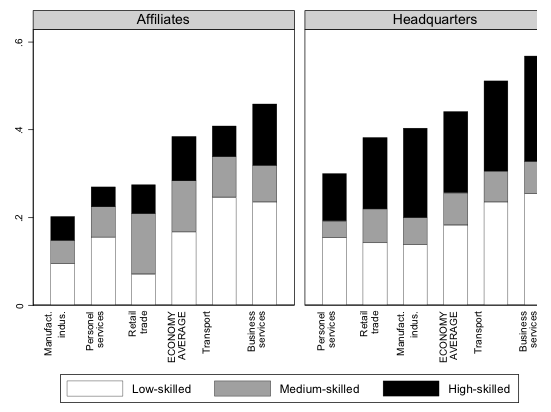How do firms organise production, and how do these strategies relate to productivity at the firm level? These questions have generated a vast, mostly theoretical literature. Among the set of mechanisms which have been investigated, Aghion and Tirole (1997) proposed that moral hazard problems might determine the decision to delegate, or not, authority to local operational managers with an informational advantage, and ultimately the size of remote affiliates. Garicano (2000) and Garicano and Rossi-Hansberg (2006) show that lower communication costs within firms act as a centralising force – when workers can communicate easily, they tend to rely more on the help of others and to specialise on a narrower set of tasks. However, the lack of data and the lack of adequate empirical settings have hindered empirical tests of such predictions.
In recent work, we contribute to filling this gap by relying on large-scale datasets covering virtually the entire population of French business organisations, be they standalone firms or larger corporate groups (Charnoz et al. 2018). We take advantage of the shock on communication costs brought about by high speed rail technology and estimate its impact on firms' organisations. To that end, we propose an original and hopefully convincing combination of identification strategies that were recently proposed in two separate literatures; namely, in corporate finance and in economic geography.
A description of the organisational structure of French corporate groups
We first rely on the classification of occupations to build a typology of functions (support activities as opposed to production activities), which we interact with hierarchical layers or ‘skills’ in a way that is similar to Caliendo et al. (2015). The resulting description of the workforce, both at headquarters and at remote production affiliates, is plotted in Figure 1 below.
Figure 1 Structure of the workforce at affiliates versus headquarters across industries
(A) Percentage of jobs allocated to support activities
(B) Percentage of jobs allocated to production activities
Source: Matched DADS files and LIFI survey.
Panel A first shows that, unsurprisingly, support activities are slightly more important, on average, at headquarters than at affiliates. However, what significantly differentiates headquarters from affiliates is not so much the weight of these functions, but the structure of skills withinthem – headquarters employ 15-20% of their workforce in higher management positions, against 5-10% in the case of affiliates. Conversely, affiliates employ around twice as many middle managers (roughly 20%) as headquarters. Panel B shows that, conversely, the structure of the workforce allocated to production activities is not highly contrasted between headquarters and affiliates.
Furthermore, the data provide evidence that the structure of the workforce at affiliates is highly differentiated across industries. The share of skilled workers allocated to support activities in affiliates is around 4% in all industries, except in business services, where it reaches 10%. Likewise, the share of skilled workers in production activities is around 10% in business services and manufacturing industries, but below 5% in all other industries.
Understanding the productivity impact of communication technologies
With this information system at hand, we take advantage of the opening of new high speed rail (HSR) lines in France between 1991 and 2011 to study the organisational and productivity effects of the introduction of this new communication technology, which decreased communication costs between newly connected headquarters and affiliates.
We address the problem of the endogenous placement of the HSR infrastructure by taking advantage of the dyadic nature of our setting, where observations are ‘pairs’ of affiliates (in one location) and headquarters (located elsewhere). This feature makes it possible to introduce high dimensional commuting zone fixed effects interacted with time fixed effects as in Giroud (2013). The latter control accurately for the demand shocks and local price effects (e.g. land prices) potentially induced by the new infrastructure, thus allowing to estimate the pure productivity effect of interest. Identification in our setting therefore comes from differential variations in communication costs across affiliates located in the same area, but belonging to differently structured multi-unit corporate groups. We also combine this empirical set-up with identification strategies put forward in the literature on economic geography (affiliates served by intermediate stations without intention to treat as in Chandra and Thompson 2000, and Banerjee et al. 2012; or evidence from un-realised lines as in Donaldson 2018).
Our regressions show that the hierarchical structure of affiliates’ support activities adjust when the HSR infrastructure becomes available. They tend to transfer the top layer of managers to headquarters when communication with HQs becomes easier, and to shrink the bottom layer. This confirms a previous result in Bloom et al. (2014) that communication technologies tend to put more power in the hands of top managers at HQs. In contrast, the share of workers allocated to support activities shrinks at remote affiliates, while their production activities grow. This increase in affiliates' production capacity can be rationalised by the reduction in moral hazard problems driven by lower information asymmetries between HQs and affiliates (Aghion and Tirole 1997), and by the reallocation of resources within corporate groups towards affiliates which become relatively cheaper to operate due to reduced communication costs. At the group level, the resulting impact on productivity (and profit) is found to be significant across all industries, ranging between 0.5 and 4%. All results are larger in service industries, where information to be transmitted is arguably softer (Petersen and Rajan 2002).
Our estimates can also be used to compute upper bounds for the productivity effect that can be expected from communication technologies. In French multi-site groups, the average travel time between HQs and affiliates is two hours. Abolishing these distances by a ‘perfect’ communication technology would increase production capacity by 4% in the service and transport industries, and by around 2% in the manufacturing, retail, and trade industries. These quantifications correspond to partial equilibrium effects, which would be associated with relatively large aggregate employment shifts because large, multi-site business organisations are prevalent in the economy – in France, they account for 56% of total employment, and the availability of more efficient communication technologies would probably increase this share.
Geographical implications of our results
Our regressions provide evidence that reduced travel times induced by HSR foster functional specialisation across the different units of a firm, as predicted by Duranton and Puga (2005) and Gervais et al. (2018). This contributes to the geographical job polarisation by functions, and more precisely to the clustering of high-skill (managerial) jobs in the largest cities, in particular in the capital city (Paris) where a large fraction (35%) of headquarters are located. The same phenomenon would most likely occur if, for example, London became connected via high speed rail to the northern part of the UK.
References
Aghion, P and J Tirole (1997), "Formal and real authority in organizations", Journal of Political Economy 105(1): 1–29.
Banerjee, A, E Duflo and N Qian (2012), "On the road: Transportation and infrastructure growth in China", mimeo.
Bloom, N, L Garicano, J Van Reenen and R Saddun (2014), "The distinct effects of information technology and communication technology on firm organization", Management Science 60(12): 2259–2885.
Caliendo, L, F Monte and E Rossi-Hansberg (2015), "The anatomy of French production hierarchies", Journal of Political Economy 123(4): 809–852.
Chandra, A and E Thompson (2000), "Does public infrastructure affect economic activity? Evidence from the rural interstate highway system", Regional Science and Urban Economics 30(4): 457–490.
Charnoz, P, C Lelarge and C Trevien (2018), "Communication costs and the internal organization of multi-plant businesses: Evidence from the impact of the French high-speed rail", CEPR, Discussion Paper 12585, and Economic Journal, forthcoming.
Donaldson, D (2018), "Railroads of the Raj: Estimating the impact of transportation infrastructure",American Economic Review108(4-5): 899–934.
Duranton, G and D Puga (2005), "From sectoral to functional urban specialization", Journal of Urban Economics 57(2): 343–370.
Garicano, L (2000), "Hierarchies and the organization of knowledge in production", Journal of Political Economy 108(5): 874–904.
Garicano, L and E Rossi-Hansberg (2006), "Organization and inequality in a knowledge economy", Quarterly Journal of Economics 121(4): 1383–1435.
Giroud, X (2013), "Proximity and investment: Evidence from plant-level data", Quarterly Journal of Economics 128(2): 861–915.
Gervais, A, J Markusen and A Venables (2018), "Inter-city specialization and trade in functions versus sectors", mimeo.
Petersen, M A and R G Rajan (2002), "Does distance still matter? The information revolution in small business lending", Journal of Finance 57(6): 2533–2570.








